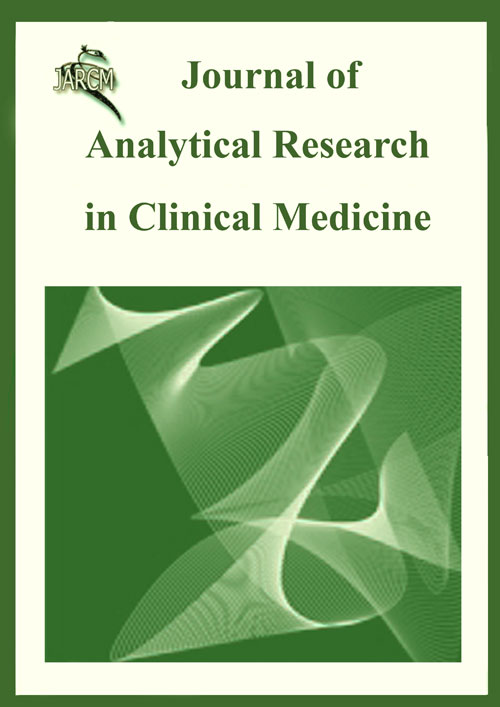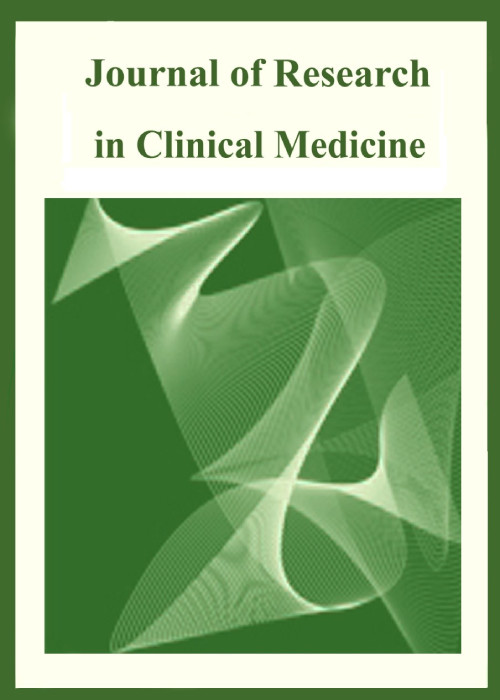فهرست مطالب

Journal of Analytical Research in Clinical Medicine
Volume:5 Issue: 4, Autumn 2017
- تاریخ انتشار: 1396/10/30
- تعداد عناوین: 7
-
Pages 110-111
-
Pages 112-117IntroductionMutation in p53 and phosphatase and tensin homolog (PTEN) genes are reported to be prevalent in endometrial cancer. The present study aimed to evaluate the immunohistochemical expression of p53 and PTEN proteins in endometrial cancer among women with hysterectomy.MethodsIn this cross-sectional study, 40 paraffin-embedded endometrial cancer samples were collected during 2015 to 2016, from women with hysterectomy in Al Zahra Hospital, Tabriz, Iran. The histopathological observation was performed to confirm endometrial cancer and its grade. Immunohistochemistry (IHC) was done for p53 and PTEN biomarkers. Data were analyzed by SPSS.ResultsThirty-three (82.5%), six (15.0%) and one (2.5%) out of 40 samples were endometrioid endometrial adenocarcinoma, serous carcinoma and clear cell adenocarcinoma, respectively. Furthermore, 5, 16 and 19 out of 40 studied samples belonged to grade I, II and III, respectively. The IHC observation showed that p53 expression in 9 (22.5%) was positive, while the rest 31 (77.5%) samples were p53 negative. Moreover, PTEN expression was observed in 10 (25%) samples and 30 (75.0%) samples were PTEN negative. The sensitivity of p53 and PTEN for diagnosis of endometrial cancer was calculated as 56.3% and 80%, respectively.ConclusionThe IHC markers, p53 and PTEN, show heterogeneous results as diagnostic and prognostic markers for endometrial carcinoma and are suggested to be used along with other markers for such purposes.Keywords: Endometrial Cancer, Immunohistochemistry, Phosphatase, Tensin Homolog, Tumor Suppressor Protein p53
-
Pages 118-121IntroductionEmergency department overcrowding can affect the process of seeking help for critically ill patients in the emergency department. The aim of this study was to investigate the relationship between crowding and clinical outcome of referred critical patients from other hospitals.MethodsThis was a retrospective cross-sectional study performed on 583 critically ill patients (triage levels one and two) referred to the emergency department of Imam Reza Hospital, Tabriz, Iran, between 22 September 2016 and 22 March 2017. Clinical outcome was considered as death rate and the crowd was measured in terms of the number of patients per hour. Statistical analysis was performed using SPSS.ResultsThe mean ± standard deviation (SD) of age was 49.5 ± 25.0 years old with 56.4% frequency of men and 43.2% women. About 53.5% of people were referred during peak hour. Evaluating the final outcome, 21.6% of patients died in the emergency department, while 41.5% and 36.9% were cured and discharged or hospitalized respectively. The mean ± SD duration of staying in the emergency department was 239.6 ± 233.0 minutes. A significant percentage of death was during the peak hour of emergency referrals. The final outcome got worse with an increased number of patients admitted to the emergency room.ConclusionCrowding in the emergency department deteriorated the treatment process of patients with a critical condition. Thus, the final outcome of the disease or the mortality rate of patients admitted to emergency worsened. Constructive measures to reduce the crowding in the emergency department should be considered.Keywords: Emergencies, Rush, Outcomes
-
Pages 122-127IntroductionChronic thromboembolic pulmonary hypertension (CTEPH) is a late complication of pulmonary thromboembolism, which is associated with high morbidity and mortality. Although the pathogenesis is not fully understood, the damage and frequency of this complication have a wide range. The aim of this study was to evaluate the incidence of CTEPH following the first episode of acute pulmonary embolism (PE).MethodsIn a cohort study, 101 patients with acute embolism who had undergone anticoagulant therapy were followed up for at least one year. Patients that presented symptoms of dyspnea were selected. Echocardiography was performed on these patients, and they were evaluated for symptoms of right heart failure and increased pulmonary artery pressure of more than 35 mmHg.Results101 patients with a mean age of 85.2 ± 17.7 years, including 57 men (56.4%) and 44 females (43.6%), were treated for a diagnosis of acute PE and were followed up for one year. 77.2% of patients had an idiopathic PE and 22.8% had it as the underlying cause. During follow-up, 23 patients (22.8%) experienced dyspnea. Echocardiography was normal in 13 cases and 10 cases had signs of right heart failure and pulmonary artery pressure. The overall incidence of CTEPH was 9.9%. Demographic data and computed tomography (CT) angiography findings were not associated with higher incidence of CTEPH.ConclusionCTEPH is a serious complication of acute PE, and the incidence of pulmonary hypertension after pulmonary emboli is relatively high. Age and gender did not influence its occurrence. Moreover, there was no relationship between the findings of CT angiography in the initial PE and chronic pulmonary hypertension rate of incidence.Keywords: Deep Venous Thrombosis, Pulmonary Embolism, Echocardiography
-
Pages 128-133IntroductionCor pulmonale or right ventricular (RV) enlargement is cardiovascular complication of the chronic obstructive pulmonary disease (COPD). Hypoxic pulmonary vasoconstriction, hypercapnia, acidosis and pulmonary vascular remodeling are suggested as possible mechanisms of cor pulmonale. In this study, we aimed to evaluate the correlation between acidosis and hypercapnia with corpulmonale in patients with COPD.MethodsIn this cross-sectional analytical study, 100 patients (56 men and 44 women with mean age of 66.53 ± 10.63 years) with moderate to severe COPD exacerbation were included. Complete history taking and physical examination as well as atrial blood gas, pulmonary function test (PFT) and echocardiography were performed. Disease severity was defined according to global initiative for obstructive lung disease (GOLD), Modified Medical Research Council (mMRC) and COPD Assessment Test (CAT) criteria. Patients with cor pulmonale were defined and findings were compared between patients with and without cor pulmonale.ResultsForty-two patients had cor pulmonale. There was no significant difference in hypercapnia between groups. Cor pulmonale patients, compared to non-cor pulmonale, had significantly lower forced expiratory volume in the first second (FEV1) (P = 0.020), higher tricuspid regurgitation (TR) (P = 0.001) and pulmonary hypertension (P = 0.020). There was significantly negative correlation between RV thickness with FEV1/forced vital capacity (FCV) (r = -0.239, P = 0.010) and RV size with FEV1/FVC (r = -0.312, P = 0.002) and positive correlation with partial pressure of carbon dioxide (PaCO2) (r = 0.312, P = 0.002) and bicarbonate (HCO3) (r = 0.258, P = 0.009).ConclusionCor pulmonale in the course of COPD accompanies with adverse outcome. These patients have worse spirometry and left ventricle echocardiographic findings, but have no difference in arterial blood gas (ABG) findings.Keywords: Chronic Obstructive Pulmonary Disease, Cor Pulmonale, Echocardiography, Spirometry
-
Pages 134-140IntroductionQT dispersion (QTd) and Tp-e interval show controversial results in incidence of sustained ventricular arrhythmias (SVA) in patients with heart failure (HF). In patients with implanted cardiac resynchronization therapy (CRT) device, there is a unique opportunity to record SVAs. The aim of this study was to evaluate the effects of QTd and Tp-e interval on the incidence of SVAs after simultaneous biventricular (Biv) pacing.MethodsIn the present study, 31 consecutive patients with advanced HF and implanted CRT device were evaluated one year for possible SVAs, corrected QT (QTc), QTd, and Tp-e interval. Patients were divided into two groups; with (group 1) and without (group 2) SVAs.ResultsAmong the studied patients, 5 (16%) experienced SVAs. The intrinsic and Biv pacing QTd were 70.74 ± 18.00 and 89.26 ± 28.00 msec, and 95.09 ± 44 and 88.09 ± 33 msec in group 1 and group 2, respectively (P = 0.18 and P = 0.16, respectively). Tp-e was not different between the two groups. In group 1, QTc increased from 438.83 ± 64 msec to 488.24 ± 48 msec (P = 0.13), and in group 2, it decreased from 499.70 ± 65.00 msec to 480.00 ± 31.00 msec after simultaneous Biv pacing (P = 0.13).ConclusionQTd, Tp-e, and QTc did not differ significantly after Biv pacing to show any positive effect on the incidence of SVAs in part due to the severity of changes which already occur in patients with advanced HF. QTc, QTd, and Tp-e showed little changes after Biv pacing and probably do not have a significant role in the incidence of SVAs.Keywords: Cardiac Resynchronization Therapy, Heart failure, Cardiac arrhythmias
-
Pages 141-145IntroductionPulmonary alveolar proteinosis (PAP) is a diffuse pulmonary disease characterized by the intra-alveolar accumulation of formless, proteinaceous material. Lipids and proteins materials with specific staining appearance in the alveoli impair pulmonary gas transfer in PAP. The severity of this condition ranges from an asymptomatic clinical presentation to respiratory failure and death. PAP is an extremely rare disorder, occurring worldwide with an estimated prevalence of 0.1 per 100000 individuals. Although the pathogenesis of PAP has remained unknown, most investigators have considered this condition to be caused by the impaired clearance of lipids and surfactant proteins from the airspaces. These functions are known to be performed by alveolar macrophages and type 2 epithelial cells. It is likely that granulocyte macrophage-colony stimulating factor (GM-CSF) dysfunction on macrophages is responsible for PAP. Primarily, in most adult patients with PAP, antibodies against GM-CSF have been observed with dysfunction of macrophages. Secondly, alveolar macrophage dysfunction plays a role in the impaired secretion of surfactant in this disease. It has been noted that both impaired secretion of surfactant and impaired phagocytosis are responsible for disease pathogenesis.
Case Report: A 40-year-old man who had suffered from a cough with sputum for more than 2 years, with no associated fever, referred to our clinic. He had been diagnosed with pneumonia and treated unsuccessfully with antibiotics. His past medical history showed that he had a chronic history of a cough, easy fatigability and shortness of breath upon mild exertion. Computed tomography (CT) imaging of the chest revealed bilateral diffuse reticulonodular opacities and a crazy-paving pattern, which was suggestive of alveolar proteinosis.ConclusionPAP is a generalized pulmonary disorder caused by the collection of formless, proteinaceous material with specific staining appearance in the alveolus.Keywords: Pulmonary alveolar proteinosis, Granulocyte macrop, Granulocyte Macrophage-Colony Stimulating Factor, Restrictive Lung Disease


